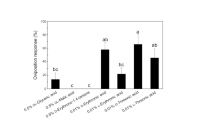Abstract
Oviposition behavior was elicited fromCatolaccus grandis (Burks) (Hymenoptera: Pteromalidae) females, an ectoparasitoid of the boll weevil,Anthonomus grandis Boheman (Coleoptera: Curculionidae), by smears of freshly cut cotton bolls or smears of extracts prepared with boll weevil damaged or undamaged cotton boll tissues. Oviposition behavior was also elicited fromC. grandis females by smears made withn-pentane,n-hexane,n-heptane, and isooctane. This is the first report of oviposition behavior elicited for any parasitoid by these short-chain saturated hydrocarbons (alkanes), introducing a new concept on the chemical mediation of parasitoid behavior during host selection. Oviposition behavior was also elicited fromC. grandis females by volatiles emanating from an artificial diet devoid of insect components that was specifically developed for the in vitro rearing of ectoparasitoids. The possible use of a synergistic combination ofn-hexane and diet to optimize the mechanized production of noncontaminated eggs is also discussed.
Similar content being viewed by others
References
Arthur, A.P., Hegdekar, B.M., andBatsch, W.W. 1972. A chemically defined synthetic medium that induced oviposition in the parasiteItoplectus conquisitor.Can. Entomol. 104:1251–1258.
Cate, J.R. 1987. A method of rearing parasitoids of boll weevil without the host plant.Southwest. Entomol. 12:211–215.
Clausen, C.P. 1940. Entomophagous Insects. McGraw-Hill, New York.
Dicke, M., Sabelis, M.W., Takabayashi, J., Bruin, J., andPosthumus, M.A. 1990. Plant strategies of manipulating predator-prey interactions through allelochemicals: Prospects for application in pest control.J. Chem. Ecol. 16:3091–3118.
Dicke, M., Barrlen, P., van Wessels, R., andDukman, H. 1993. Herbivory induces systematic production of plant volatiles that attract the herbivore's predators: Extraction of endogenous elicitor.J. Chem. Ecol. 19:581–599.
Doutt, R.L. 1959. The biology of parasitic Hymenoptera.Annu. Rev. Entomol. 4:161–182.
Guerra, A.A., andRobacker, K.M. 1991. Potential larval diet devoid of hemolymph for in vitro rearing ofBracon mellitor. Proceedings, Beltwide Cotton Conference, San Antonio, Texas, Vol. 2, p. 73.
Guerra, A.A., Robacker, K.M., andMartinez, S. 1993. In vitro rearing ofBracon mellitor andCatolaccus grandis with artificial diets devoid of insect components.Entomol. Exp. Appl. 68:303–307.
Henson, R.D., Vinson, S.B., andBarfield, C.S. 1977. Ovipositional behavior ofBracon mellitor Say, a parasitoid of the boll weevil (Anthonomus grandis Boheman) III. Isolation and identification of a natural releasers of ovipositor probing.J. Chem. Ecol. 3:151–158.
Hassel, M.P. 1968. The behavioral response of a tachinid fly [Cyzenis albicans (Fall)] to its host, the winter moth [Operophtera brumata (L.)].J. Anim. Ecol. 37:627–639.
Morales-Ramos, J.A., andKing, E.G. 1991. Evaluation ofCatolaccus grandis (Burks) as a biological control agent against the cotton boll weevil. Proceedings, Beltwide cotton Conference, National Cotton Council, Memphis, Tennessee, p. 724.
Nettles, W.C., Jr., andBurks, M.L. 1975. A substance from Heliothis virescens larvae stimulating larviposition by females of the tachinidArchytas marmoratus.J. Insect Physiol. 21:965–978.
Nettles, W.C., Jr., andMorrison, R.K., Xie, Z.N., Ball, D., Shenkir, C.A., andVinson, S.B. 1983. Effect of cations, anions and salt concentration on oviposition byTrichogramma pretiosium in wax eggs.Entomol. Exp. Appl. 33:283–289.
Nordlund, D.A., Jones, R.L., andLewis, W.J. (eds.). 1981. Semiochemicals, Their Role in Pest Control. Wiley & Sons, New York, 306 pp.
SASInstitute. 1990. SAS/STAT Guide for Personal Computers. Vol. 6. SAS Institute, Cary, North Carolina.
Steinberg, S., Dicke, M., andVet, L.W.M. 1993. Relative importance of infochemicals from first and second trophic level in long-range host location by the larval parasitoidCotesia glomerata.J. Chem. Ecol. 19:47–59.
Summy, K.R., Morales-Ramos, J.A., andKing, E.G. 1993. Ecology and potential impact ofCatolaccus grandis (Burks) on boll weevil infestations in the Lower Rio Grande Valley.Southwest. Entomol. 17:279–288.
SYSTAT. 1989. SYSTAT: Statistics Version 5.1. SYSTAT, Inc., Evanston, Illinois.
Thompson, A.C., Roth, J.P., andKing, E.G. 1983. Larviposition kairomone of the tachinidLixophaga diatraea.Environ. Entomol. 12:1312–1314.
Vinson, S.B. 1976. Host selection by insect parasitoid.Annu. Rev. Entomol. 21:109–133.
Vinson, S.B. 1981. Habitat location, pp. 51–77,in D.A. Nordlund, R.L. Jones, and W.J. Lewis (eds.). Semiochemicals: The Role in Pest Control. Wiley, New York.
Vinson, S.B., Jones, R.L., Sonnet, R., Beirl, B.A., andBeroza, M. 1975. Isolation, identification and synthesis of host-seeking stimulants forCardiochiles nigricep, a parasitoid of the tobacco budworm.Entomol. Exp. Appl. 18:443–450.
Author information
Authors and Affiliations
Additional information
Mention of a commercial or proprietary product does not constitute an endorsement by the USDA.
Rights and permissions
About this article
Cite this article
Guerra, A.A., Martinez, S. & Sonia Del Rio, H. Natural and synthetic oviposition stimulants forCatolaccus grandis (Burks) females. J Chem Ecol 20, 1583–1594 (1994). https://doi.org/10.1007/BF02059882
Received:
Accepted:
Issue Date:
DOI: https://doi.org/10.1007/BF02059882




